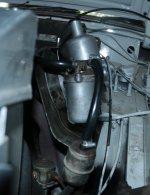I don't know what angle is correct for Spridgets. Mini, Spridget, and (I think) Austin America intake manifolds look similar but are cut at different angles so SU makes different angle grommets to set the float bowl vertical. Others will have to comment on what combination of grommets and manifold are correct for your car.
I assume that when you say the float level is not adjustable... you mean the carb has the all plastic float, not the plastic float with the metal arm. Setting the float height on with the metal/plastic floats is done by bending the metal float arm. If you have the all plastic floats, there still is adjustment but I don't know that it is described in any manual that I have ever seen and the rebuild kits never come with what you need (always save old parts). To set the all plastic float height, change the thickness and number of fiber washers between the float valve and the bowl lid. Ideally, if you run the engine, switch off, and remove the float bowl lid with float, the bowl will be between 1/2 and 2/3 full of gas. If the level is higher than 2/3 you need to add fiber washers.
You say the float valves are new. Are they "traditional" all metal, Viton tipped brass, or ball-bearing type Grose Jets? If Grose jets, remove them and either: 1) throw them away, or 2) as a minimum, soak them in carb cleaner, then flush them out with spray carb cleaner and compressed air. New ones ship with a protective coating to keep the balls from rusting in storage. The coating can prevent the balls from sealing or can cause them to stick in place. Personally, I prefer the Viton tipped needles but there is nothing wrong with the all brass OEM type.
Assuming the float valves are closing and the level is set "right", you may have some drainage into/out of the jet if the rubber fuel line connected to the carbs is routed higher than the lids. Any residual fuel in the hose above the lid has got to go somewhere when you stop the engine and even with good float valves you can expect a little to seep past the float valves. Keep the rubber lines as low as possible.


 Hi Guest!
Hi Guest!

 smilie in place of the real @
smilie in place of the real @
 Pretty Please - add it to our Events forum(s) and add to the calendar! >>
Pretty Please - add it to our Events forum(s) and add to the calendar! >> 